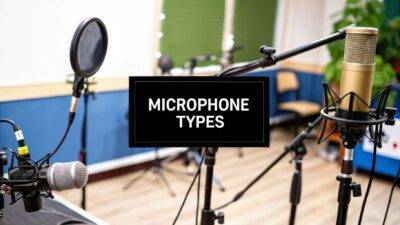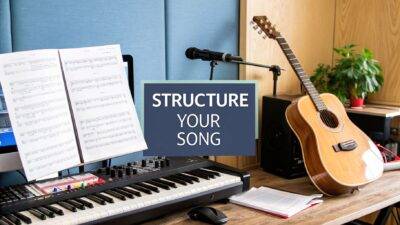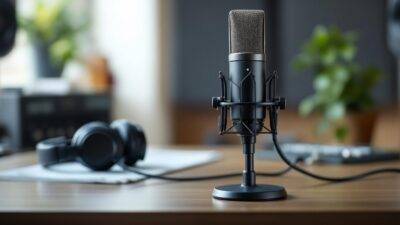Diving into the world of music production can feel overwhelming, especially when faced with expensive and complex software. The good news is that you no longer need a lavish budget to start creating professional-sounding tracks. An incredible array of powerful, full-featured, and completely free music production software for beginners is available, providing everything necessary to record, arrange, mix, and master your ideas from the comfort of your home studio. This guide is designed to cut through the noise and help you find the perfect Digital Audio Workstation (DAW) or music-making app for your specific needs and creative workflow.
This comprehensive resource moves beyond simple feature lists. We provide an in-depth analysis of the top free DAWs available today, including established powerhouses like Cakewalk by BandLab and user-friendly starting points like GarageBand. For each option, you will find a detailed breakdown that covers:
- Practical Use Cases: Discover which software excels at beat-making, vocal recording, electronic music, or podcasting.
- Honest Limitations: Understand what each free version can and cannot do, so you can make an informed choice without hitting unexpected paywalls.
- Key Feature Analysis: We pinpoint the specific tools and functions that make each platform unique and valuable for a beginner.
- Workflow Insights: Learn how the interface and design of each program will impact your creative process.
Each entry includes screenshots for a clear visual reference and direct links to get you started immediately. Whether you are an aspiring producer, a songwriter looking to bring lyrics to life, or an artist building a home setup, this list will equip you with the knowledge to select the right tools and begin your music production journey with confidence. Let’s explore the best free software to turn your musical vision into reality.
1. Top 10 Best Free DAWs for Music Production in 2025
For newcomers navigating the world of digital audio, the sheer volume of software options can be overwhelming. The ChordX "Best Free DAWs" guide serves as a definitive starting point, eliminating guesswork by providing an expertly curated list of the industry's top no-cost production suites. It stands out not just as a list but as a comprehensive resource designed to guide beginners toward the ideal software for their specific creative goals.
This guide distinguishes itself from other roundups through its meticulous, professional-grade analysis. Instead of just listing features, it delves into the practical applications of each DAW, offering insights on workflow, user interface, and overall suitability for those just starting out. This makes it an indispensable tool for anyone looking for powerful free music production software for beginners without the financial commitment of a high-end program.
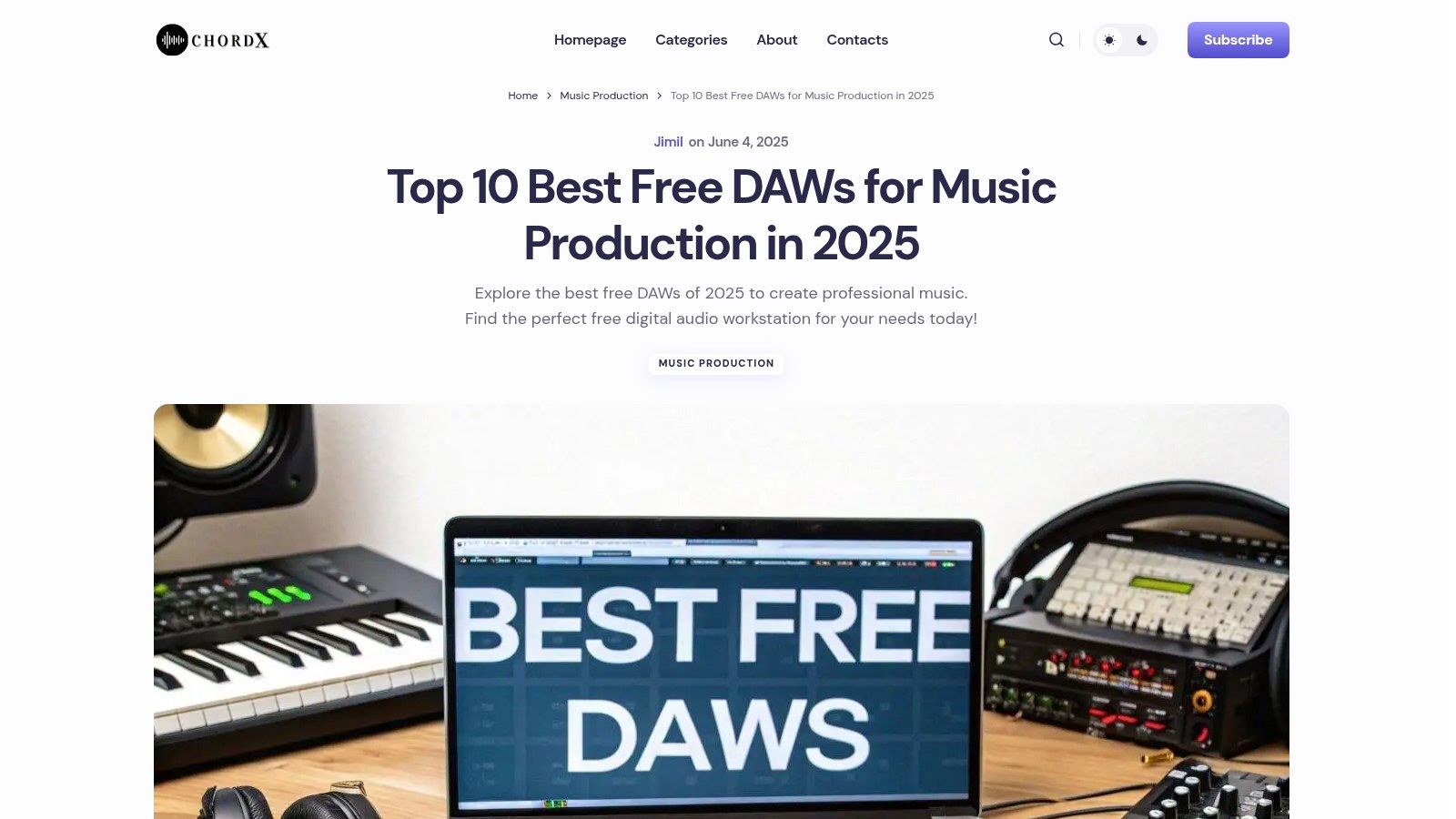
Why It’s the Top Resource
The ChordX list earns its top spot by acting as a master key to the world of free music software. It critically evaluates industry-recognized platforms like GarageBand, Reaper (via its extended trial), and Audacity, contextualizing their strengths and limitations for a beginner's workflow. The content is crafted to be both educational and actionable, ensuring you understand not just what a DAW does, but how it can be leveraged for recording, MIDI programming, mixing, and mastering.
Key Advantage: ChordX's guide is more than a list-it’s a curated educational experience. It provides the strategic insight needed to select software that aligns with your long-term musical ambitions, preventing the common pitfall of choosing a tool that you will quickly outgrow.
Core Strengths & Practical Use
- Expert Curation: Each DAW is handpicked and vetted by music production professionals, ensuring every recommendation is credible and relevant for 2025.
- Comprehensive Breakdowns: The guide details each software's ideal use case, from podcasting and vocal recording in Audacity to full-scale electronic music production in more feature-rich options.
- Beginner-Centric Focus: The analysis is tailored to novice users, explaining complex concepts in an accessible way and highlighting platforms with gentle learning curves.
- Holistic Guidance: The resource often links to supplementary content, providing a broader educational ecosystem. For instance, after choosing your DAW, you can explore their guide on setting up your first home studio to complete your production environment.
Access: The guide is available completely free on the ChordX website.
Visit the ChordX Best Free DAWs Guide
2. LMMS (Linux MultiMedia Studio)
LMMS, or Linux MultiMedia Studio, is a powerful piece of free music production software for beginners that mirrors the functionality of commercial DAWs like FL Studio. It is a completely free, open-source, and cross-platform application, meaning you can use it on Windows, macOS, and Linux without any feature restrictions or hidden costs. Its workflow is centered around creating patterns in the Song-Editor, making it exceptionally intuitive for electronic music producers who enjoy loop-based composition.
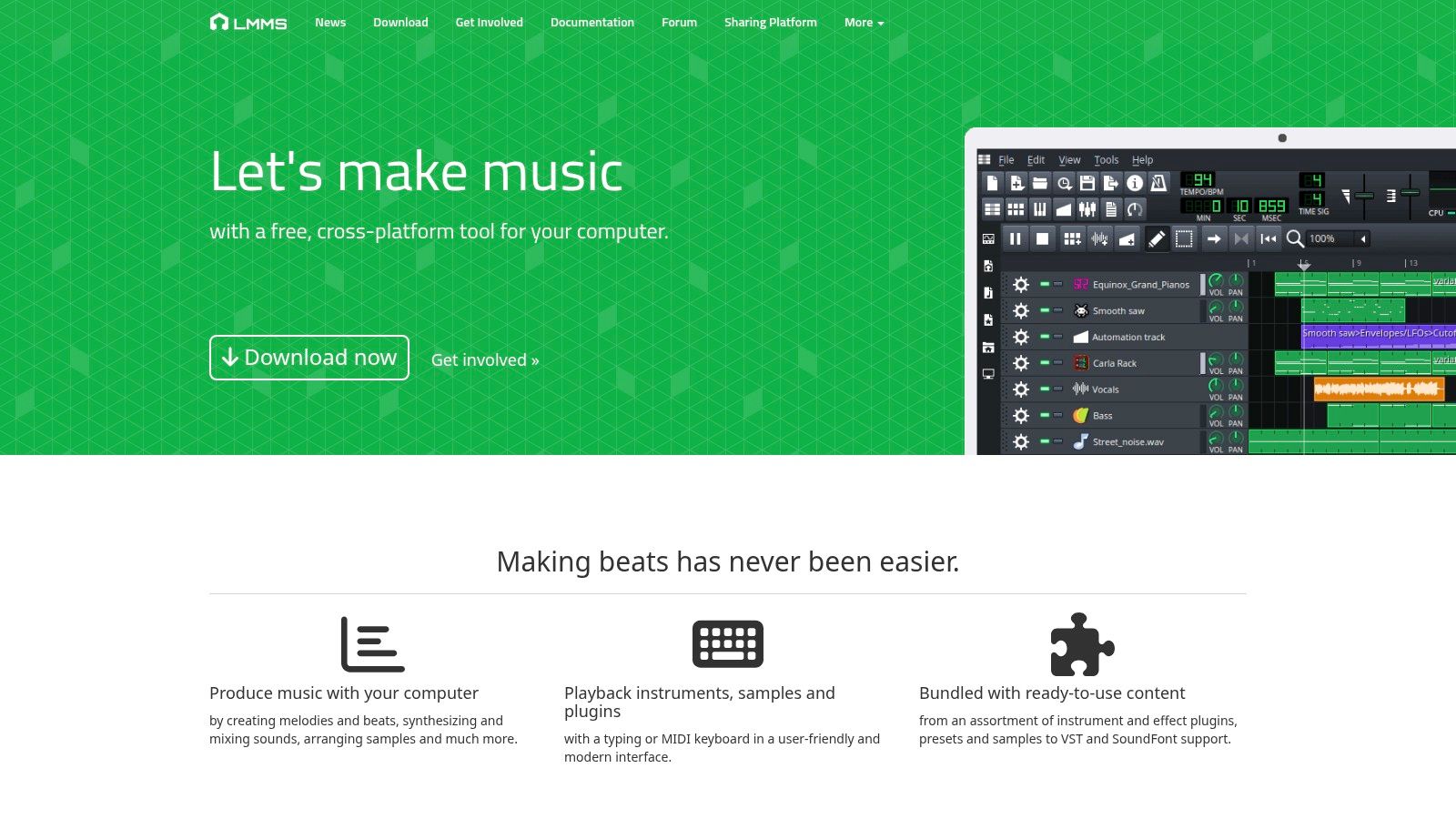
What makes LMMS stand out is its robust feature set offered at a zero-dollar price point. It includes a dedicated Beat+Bassline Editor for quickly programming drum patterns, a sophisticated Piano Roll for detailed melody and chord work, and an array of built-in synthesizers and effects.
Key Features and User Experience
The user interface, while functional, might feel a bit dated compared to modern DAWs. However, this simplicity can also be an advantage, preventing newcomers from getting overwhelmed. The real power of LMMS lies in its extensibility.
- Plugin Support: It supports VST (Virtual Studio Technology) and LADSPA plugins, allowing you to expand your sound library with thousands of third-party instruments and effects.
- Built-in Instruments: Comes with excellent native synths like TripleOscillator and ZynAddSubFX, providing a solid sonic foundation out of the box.
- Active Community: A strong, active community provides tutorials, user-made presets, and support through forums, which is invaluable for learning.
Limitations and Practical Advice
The primary limitation of LMMS is its lack of audio recording capabilities. You cannot directly record vocals or live instruments into the software, making it better suited for producers working with MIDI, samples, and virtual instruments. Despite a potential learning curve for those new to music production, the resources available can help you get started. For more guidance on DAWs and production techniques, check out these music production tips.
Website: https://lmms.io/
3. GarageBand by Apple
For those within the Apple ecosystem, GarageBand is arguably the most accessible and powerful piece of free music production software for beginners available. Pre-installed on all Macs, iPhones, and iPads, it provides a seamless entry point into music creation without any additional cost. It is designed from the ground up to be intuitive, allowing newcomers to start recording, arranging, and mixing music with a minimal learning curve.
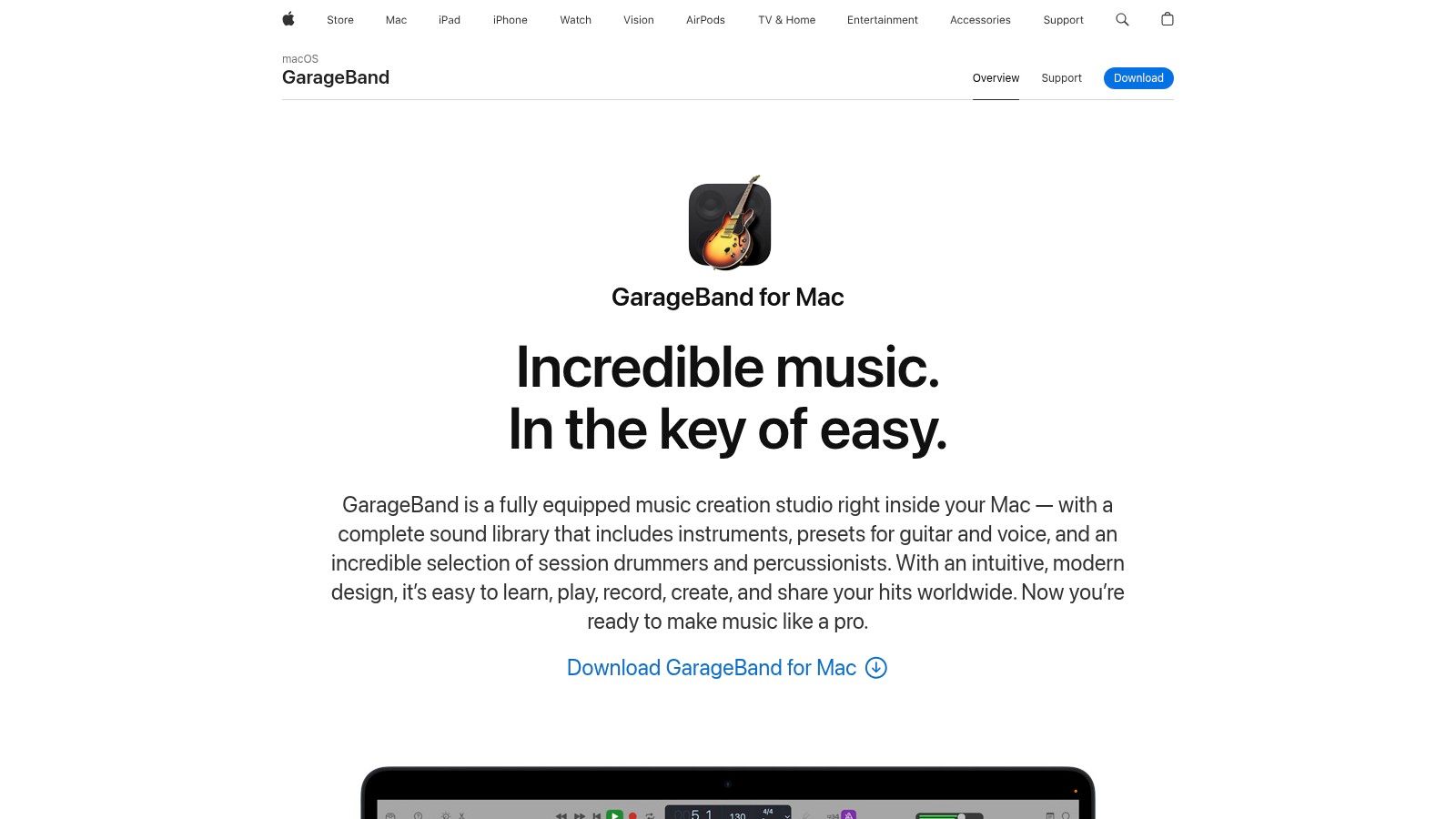
What makes GarageBand exceptional is its polished user experience and surprisingly high-quality sound library. It bridges the gap between a fun, easy-to-use app and a genuinely capable digital audio workstation, making it perfect for everything from sketching out song ideas to producing finished tracks. Its seamless integration with professional DAWs like Logic Pro X also provides a clear upgrade path for users who eventually want more advanced features.
Key Features and User Experience
The interface is clean, modern, and visually guided, which is a significant advantage for beginners. You can choose from templates for different project types like "Songwriter" or "Electronic," which pre-loads helpful tracks and settings.
- Multi-track Recording: Unlike some free options, GarageBand fully supports audio recording. You can easily record vocals, guitars, and other live instruments.
- Extensive Sound Library: It comes packed with a vast collection of professional-sounding virtual instruments, Apple Loops in various genres, and high-quality effects.
- Built-in Lessons: A standout feature is the inclusion of free, built-in lessons for guitar and piano, helping you improve your instrumental skills as you learn production.
Limitations and Practical Advice
The most significant limitation is its exclusivity to Apple devices; Windows and Android users cannot access it. While it is very capable, it lacks some of the advanced mixing, routing, and editing features found in professional-grade DAWs. However, its capabilities are more than enough to produce broadcast-quality music, especially when paired with the right entry-level gear. For advice on what to buy, you can explore some great beginner music production equipment.
Website: https://www.apple.com/mac/garageband/
4. BandLab
BandLab has redefined the entry point for music creation by offering a completely cloud-based DAW that requires no installation. As a piece of free music production software for beginners, it excels in accessibility and collaboration. Users can start a project on their laptop via a web browser and seamlessly continue it on their phone or tablet, making it perfect for capturing ideas on the go. Its core strength lies in its social and collaborative features, allowing multiple users to work on the same track in real-time.

What makes BandLab exceptional for newcomers is its all-in-one ecosystem. It combines a multi-track editor with a vast library of loops and virtual instruments, and even includes integrated mastering tools powered by AI. This removes the initial hurdle of finding and configuring separate tools, providing a complete production environment from start to finish, entirely for free.
Key Features and User Experience
The interface is clean, modern, and highly intuitive, clearly designed to reduce the learning curve for aspiring producers. The user experience is centered around speed and ease of use, from dragging and dropping loops to recording audio directly into a project.
- Real-time Collaboration: Invite friends or other BandLab users to your project and work on tracks together, no matter where you are.
- Cross-Platform Accessibility: Start, edit, and finish your music on any device with a browser or the dedicated iOS and Android apps.
- Extensive Free Library: Access thousands of professionally created loops, samples, and virtual instruments without any hidden costs.
- Integrated Mastering: Finish your track with an automated mastering service to give it a professional-sounding polish before sharing it with the world.
Limitations and Practical Advice
BandLab's biggest strength is also its main limitation: it is entirely dependent on a stable internet connection for most of its functionality. While some offline use is possible on the mobile apps, the full experience requires you to be online. It may also lack the deep, complex routing and advanced editing capabilities found in professional desktop DAWs. However, for beginners focused on songwriting, collaboration, and learning the fundamentals of arrangement and mixing, BandLab is an unparalleled and completely free starting point.
Website: https://www.bandlab.com/
5. Cakewalk by BandLab
Cakewalk by BandLab represents a unique offering in the world of free music production software for beginners: a fully-featured, professional-grade digital audio workstation (DAW) available at no cost. Formerly a premium product known as SONAR, its acquisition by BandLab made its complete, award-winning feature set accessible to everyone. This makes it an ideal choice for producers who want to learn on a platform with the power and depth they can grow into professionally.
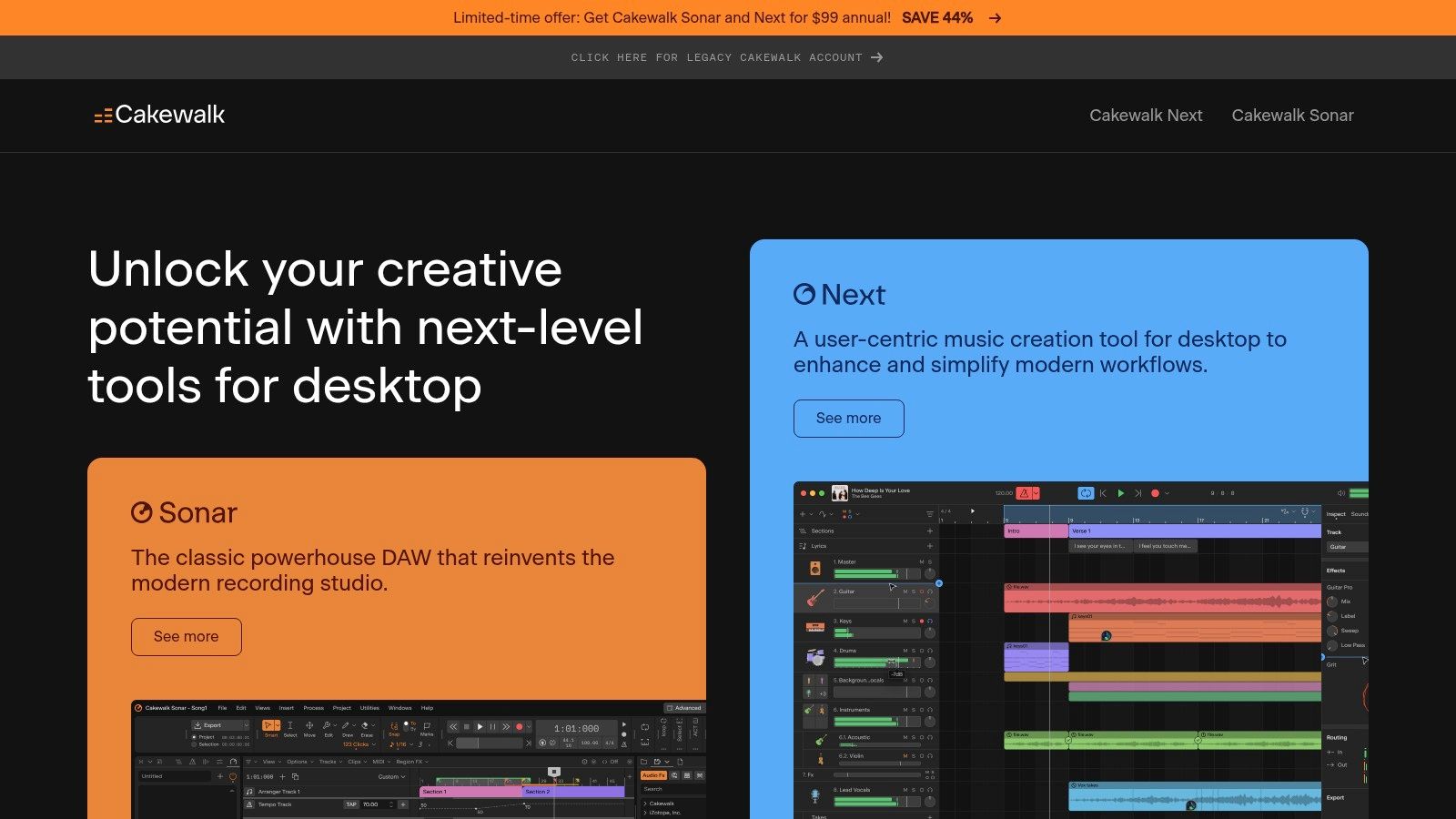
What truly sets Cakewalk apart is that it provides an unlimited creative environment. Unlike many free DAWs that impose track limits or withhold advanced features, Cakewalk offers unlimited audio, MIDI, and instrument tracks, along with a suite of high-quality effects and virtual instruments. This comprehensive toolset supports every stage of production, from initial composition and recording to mixing and mastering.
Key Features and User Experience
The user interface is clean, modern, and highly customizable, resembling other top-tier professional DAWs. While this comprehensive layout can present a steeper learning curve for absolute beginners compared to simpler tools, it pays off by teaching industry-standard workflows from the start.
- ProChannel Console Strip: Integrated into every channel, this feature provides console-style EQ, compression, and tube saturation, allowing for sophisticated and professional-sounding mixes.
- Advanced Plugin Support: Cakewalk supports the latest VST3 plugin standard and ARA (Audio Random Access) for seamless integration with tools like Melodyne.
- Comprehensive Toolset: It includes powerful MIDI editing tools, high-quality virtual instruments, and an array of effects, providing everything needed to produce a finished track.
Limitations and Practical Advice
The most significant limitation is its platform exclusivity; Cakewalk is only available for Windows users, with no native macOS or Linux version. For newcomers, the sheer number of features might feel overwhelming at first. To manage this, focus on mastering one section at a time, such as the piano roll or basic audio recording, before exploring advanced mixing modules like the ProChannel.
Website: https://www.bandlab.com/products/cakewalk
6. Audacity
Audacity is a legendary name in the world of free audio software. While not a traditional Digital Audio Workstation (DAW) with MIDI sequencing, it excels as a powerful, open-source audio editor and recorder. For beginners looking to record live instruments, vocals for a track, or edit samples, Audacity is an indispensable piece of free music production software. Its strength lies in its direct, no-fuss approach to audio manipulation, making it perfect for tasks like podcasting, sound design, and basic multi-track recording.
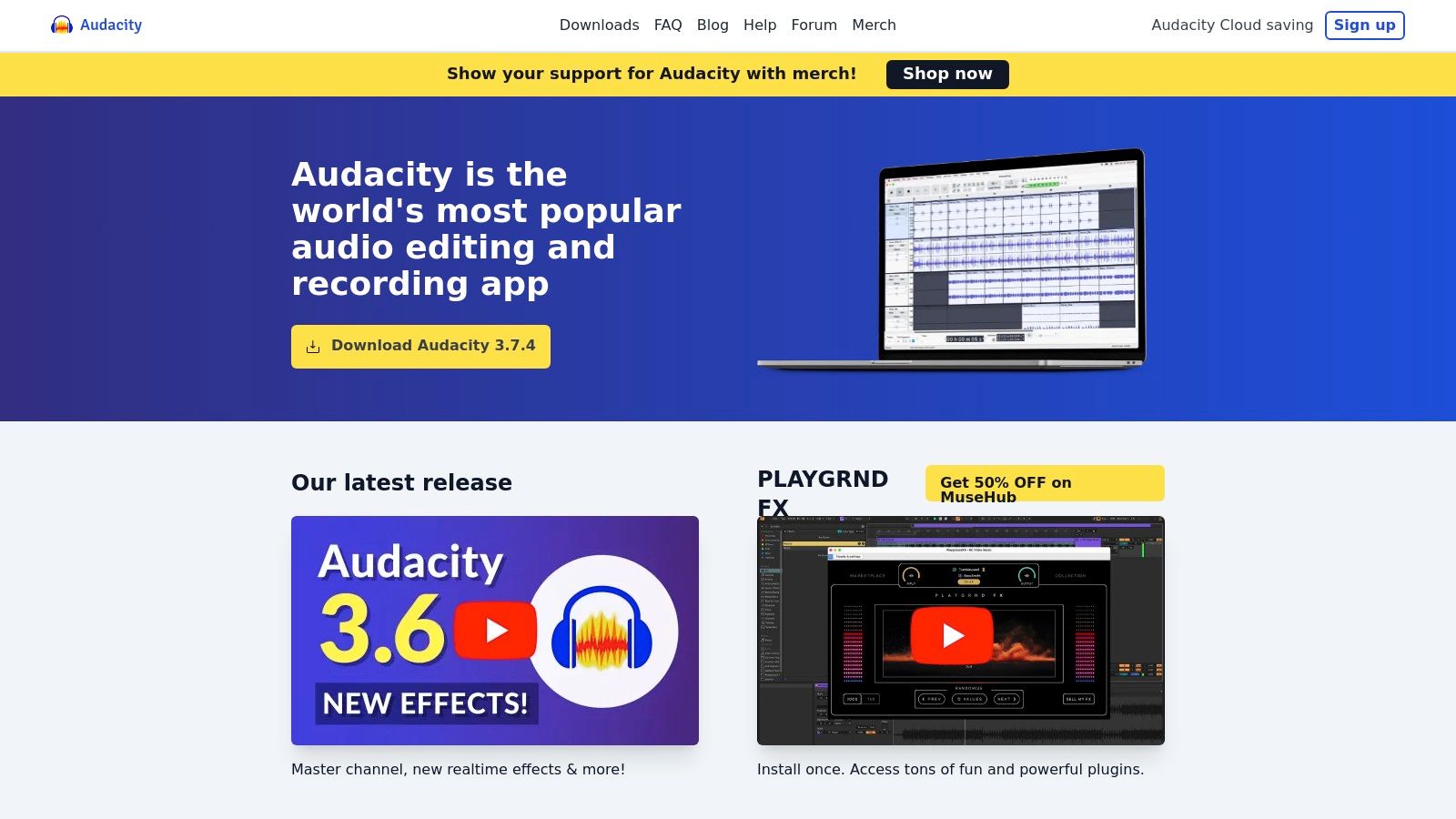
What makes Audacity a go-to for so many is its simplicity combined with a surprisingly deep set of features. It's completely free, with no hidden costs or premium versions, and runs efficiently on Windows, macOS, and Linux. For a budding producer, it is the ideal tool for capturing audio ideas quickly and performing essential editing tasks like trimming, normalizing, and applying effects before importing the audio into a more comprehensive DAW.
Key Features and User Experience
The user interface of Audacity is functional and straightforward, though it may appear dated compared to modern music software. This simplicity, however, makes it incredibly approachable for newcomers who just need to record and edit audio without a steep learning curve. The real power comes from its robust editing capabilities and extensibility.
- Multi-track Recording: Easily record multiple audio tracks simultaneously, perfect for layering vocals or recording several instruments.
- Extensive Effects and Analysis: Comes with a wide range of built-in effects like equalization, compression, reverb, and powerful audio analysis tools.
- Audio Restoration: Includes excellent noise reduction and audio repair tools, which are invaluable for cleaning up imperfect recordings.
- Plugin Support: Supports VST, AU, and LADSPA plugins, allowing you to expand its functionality with third-party effects.
Limitations and Practical Advice
Audacity's primary limitation is its lack of MIDI support and virtual instrument hosting, which prevents it from being a complete music production solution. It is best used as a dedicated audio recorder and editor alongside a MIDI-capable DAW like LMMS or Cakewalk. Use it to record your guitar or vocals, clean up the takes, and then export the polished audio files for arrangement in your main production software.
Website: https://www.audacityteam.org/
7. Tracktion T7
Tracktion T7 is a remarkably generous offering, providing a previous version of their flagship DAW completely free of charge. Unlike many 'lite' versions, T7 comes with unlimited audio and MIDI tracks, making it a serious contender for the best free music production software for beginners who don't want to feel restricted. Its single-screen, drag-and-drop interface is designed for an intuitive and fast workflow, which helps newcomers grasp production concepts without navigating complex menus.
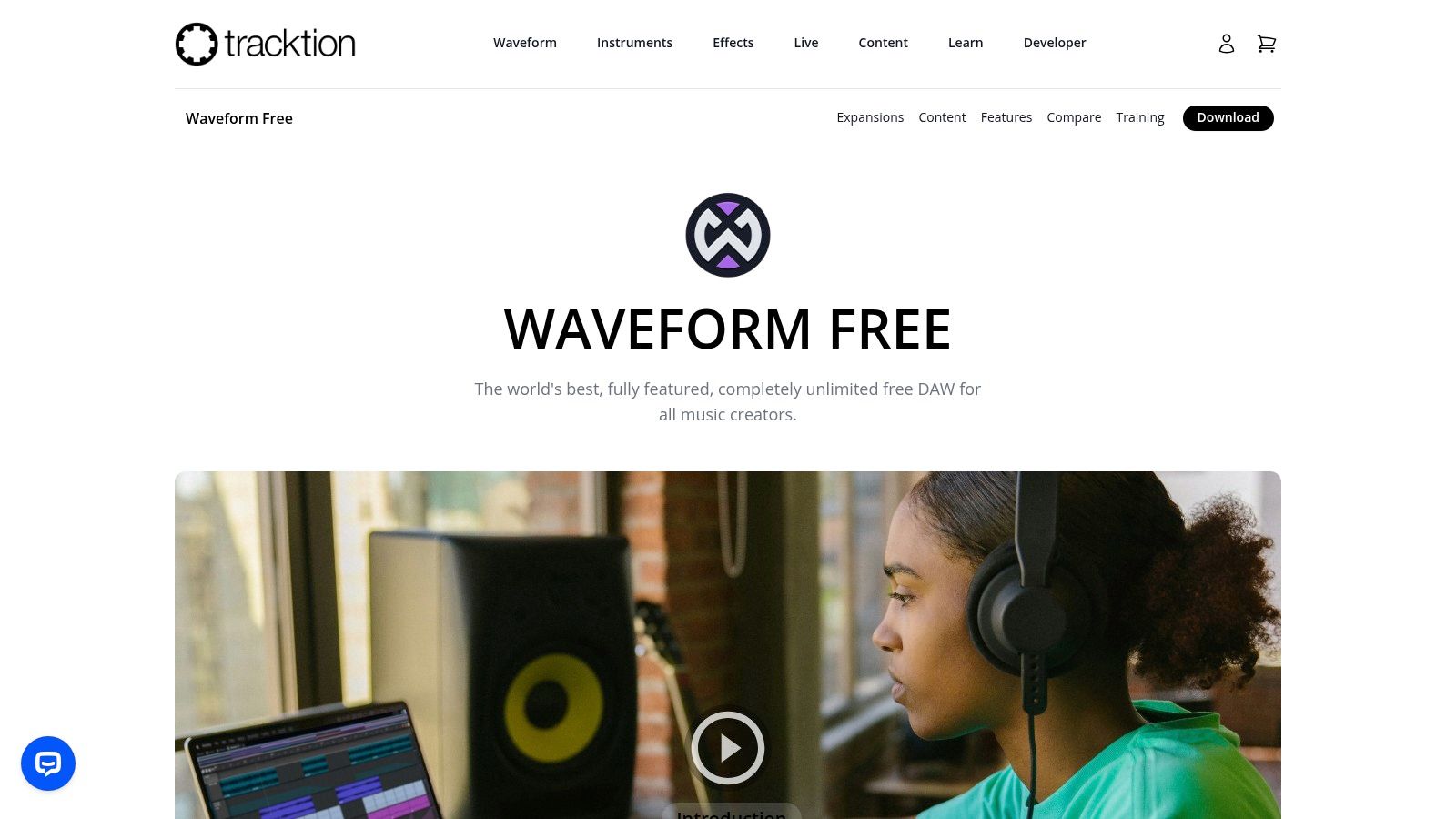
What truly sets Tracktion T7 apart is that it provides a full, professional-level digital audio workstation experience for free. It's not a stripped-down app; it's a powerful tool capable of handling complex projects from recording and composition to mixing and mastering. This makes it an ideal starting point for producers who anticipate their projects growing in scope.
Key Features and User Experience
The user interface is clean and consolidated, which can significantly reduce the learning curve for aspiring producers. All major functions like editing, mixing, and plugin management are accessible from one screen, which encourages a fluid creative process.
- Unlimited Tracks: The freedom to add as many audio and MIDI tracks as your computer can handle is a professional feature rarely found in free software.
- Comprehensive Tools: It includes a solid suite of built-in effects, automation capabilities, and VST plugin support to expand your sound palette.
- Intuitive Workflow: The "in-line" editing and contextual menus are designed to speed up common tasks, letting you focus more on creativity and less on navigation.
Limitations and Practical Advice
As Tracktion T7 is an older, unsupported version, you will not receive official updates or dedicated customer support. This means you’ll rely on community forums and online tutorials for help. While it is incredibly powerful, it may lack the very latest features or workflow enhancements found in Tracktion's paid DAW, Waveform. For beginners, however, T7 provides more than enough power to produce high-quality music without spending a cent.
Website: https://www.tracktion.com/products/t7-daw
8. Waveform Free by Tracktion
Waveform Free is the impressively capable, no-cost version of Tracktion’s flagship Waveform Pro DAW. It stands out by offering an unlimited track count, a feature typically reserved for paid software, making it a fantastic piece of free music production software for beginners who don't want to feel restricted as their projects grow. Its single-screen, workflow-oriented design aims to keep everything you need accessible without navigating complex menus.

What truly sets Waveform Free apart is its commitment to providing a professional-level experience without a price tag. Unlike many "lite" versions that impose severe limitations, Tracktion gives users a powerful foundation that can handle complex arrangements, extensive plugin use, and detailed automation right from the start.
Key Features and User Experience
The interface is modern and intuitive, although its unique workflow might require a short adjustment period for users accustomed to more traditional DAWs. Once familiar, the layout is efficient and designed for creativity.
- Unlimited Tracks: You can add as many audio and MIDI tracks as your computer can handle, providing complete creative freedom.
- Full Plugin Support: Waveform Free is fully compatible with VST and AU plugins, allowing you to expand your sound palette with a vast universe of third-party instruments and effects.
- Professional Tools: It includes features like advanced automation, a powerful MIDI editor, and a respectable suite of built-in effects, offering more than enough to produce a complete track.
Limitations and Practical Advice
The primary limitation is that some of the more advanced features, like the Arranger Track and Melodyne integration, are reserved for the paid version. However, the core functionality provided is more than sufficient for beginners and even intermediate producers. To get started, focus on understanding the "drag-and-drop" nature of its workflow; for instance, you can drag plugins directly onto tracks to apply them.
Website: https://www.tracktion.com/products/waveform-free
9. SoundBridge
SoundBridge is a sleek and modern DAW designed with simplicity and accessibility in mind, making it an excellent choice for those just starting their music production journey. It offers a fully-featured digital audio workstation experience at no cost, focusing on providing all the essential tools without overwhelming new users. The developers aim to keep the main software free forever, funding development through paid plugins, ensuring beginners have a stable, long-term platform.
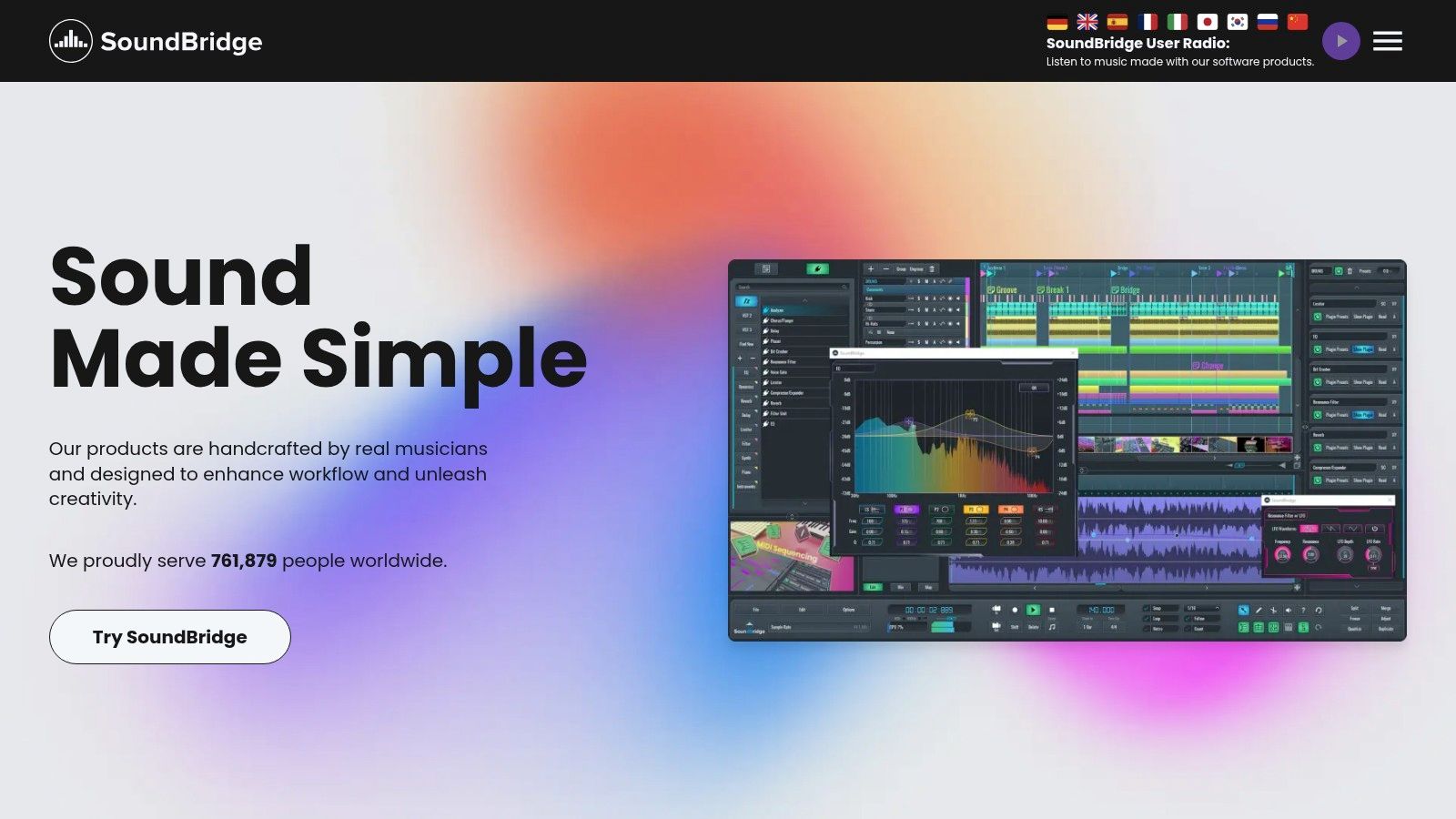
What truly sets SoundBridge apart is its clean, uncluttered interface and unique support for touchscreens, allowing for a more hands-on, intuitive creation process on compatible devices. This focus on a streamlined workflow makes it one of the most approachable pieces of free music production software for beginners available.
Key Features and User Experience
The user experience in SoundBridge is exceptionally friendly. Its interface is designed to be learned quickly, removing the steep learning curve associated with more complex, professional-grade DAWs. It supports all the core functions a producer needs to create a full track from start to finish.
- Plugin Support: Full compatibility with VST plugins allows you to expand your sound palette with a vast world of third-party instruments and effects.
- Built-in Drum Machine: It includes a dedicated drum machine and sequencer named Ritmix, which simplifies the process of creating beats and rhythmic patterns.
- Touchscreen Compatibility: A standout feature that provides a tactile and interactive way to compose music, perfect for users with tablets or touch-enabled laptops.
- Cross-Platform: Works seamlessly on both Windows and macOS, offering a consistent experience regardless of your operating system.
Limitations and Practical Advice
While SoundBridge is powerful, its primary limitation is the lack of some advanced features found in paid DAWs, like complex routing or video integration. To download the software, you must first register for a free account on their website. Despite this, the regular updates and included sample library provide significant value, making it a robust starting point for any new producer.
Website: https://soundbridge.io/
10. Ardour
Ardour is a professional-grade, open-source digital audio workstation that offers an incredible depth of features, rivaling many expensive commercial DAWs. While powerful, it presents itself as a more traditional recording and mixing environment, making it a piece of free music production software for beginners who are serious about learning industry-standard workflows. It is fully featured and cross-platform, running on Windows, macOS, and Linux, though pre-compiled versions for Windows and macOS require a small, one-time payment (as low as $1) to support development.
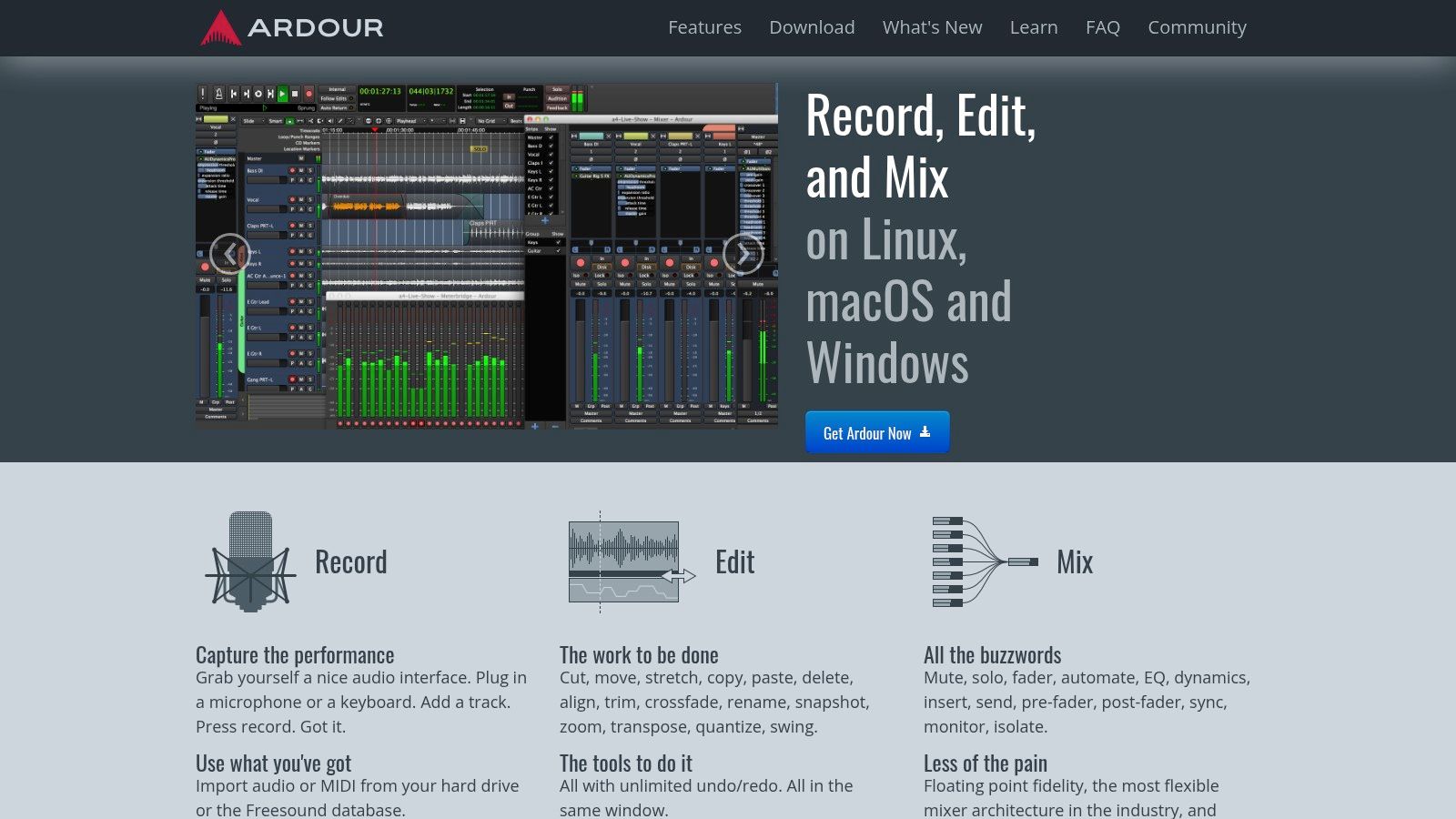
What sets Ardour apart is its commitment to professional audio standards. It boasts unlimited audio and MIDI tracks, a comprehensive mixer with advanced routing capabilities, and non-destructive editing. This makes it an excellent choice for recording bands, tracking vocals, or undertaking complex mixing projects that other free options struggle to handle.
Key Features and User Experience
Ardour’s interface is clean but dense, reflecting its professional focus. Beginners will face a steeper learning curve compared to more streamlined DAWs, but the payoff is a deep understanding of audio engineering principles. The platform is highly customizable, allowing users to tailor the workflow to their specific needs.
- Extensive Plugin Support: It fully supports VST, LV2, and LADSPA plugins, giving you access to a massive ecosystem of free and paid instruments and effects.
- Advanced Editing and Mixing: Features non-destructive, non-linear editing with unlimited undos, plus a powerful mixer that can handle complex routing scenarios like busses and sends with ease.
- Strong Community: Backed by an active community and dedicated developers, ensuring regular updates, improvements, and user support through forums.
Limitations and Practical Advice
The primary hurdle for newcomers is the complexity; it's not designed for quick beat-making. Some initial configuration may be needed, especially regarding audio drivers. However, for those aspiring to become audio engineers or producers working with live instruments, investing time in learning Ardour provides a powerful, no-cost foundation that can handle demanding projects from start to finish.
Website: https://ardour.org/
11. Qtractor
Qtractor is a dedicated piece of free music production software for beginners built exclusively for the Linux operating system. As a free, open-source digital audio workstation, it provides a traditional, linear workflow focused on multi-track audio and MIDI sequencing. It's an excellent choice for Linux users who want a lightweight yet capable tool that handles both live audio recording and MIDI composition without overwhelming them with a complex interface.
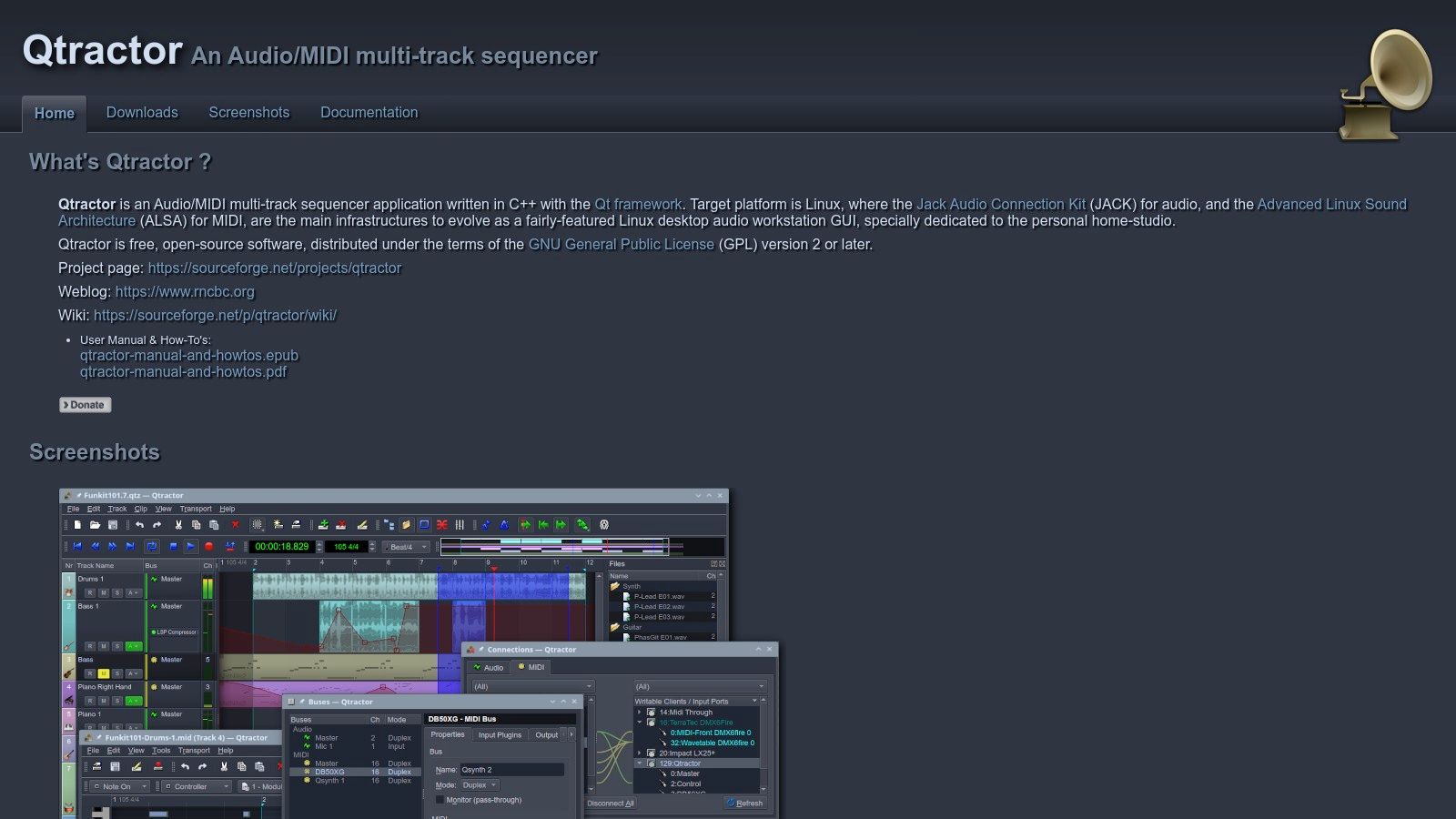
What makes Qtractor stand out is its efficiency and straightforward design. It aims to be a practical and robust application for home studios, offering non-destructive editing that lets you experiment freely without permanently altering your original audio files. This makes it a forgiving environment for newcomers learning the ropes of arranging and mixing.
Key Features and User Experience
The user interface is clean and functional, prioritizing utility over aesthetics. While it may not look as modern as some commercial DAWs, its layout is logical and easy to navigate. The real strength of Qtractor lies in its core sequencing and plugin integration.
- Plugin Support: It has excellent support for Linux-native plugin formats, including LADSPA, DSSI, LV2, and even VST plugins via a compatibility layer, giving you access to a wide range of free and commercial effects and instruments.
- Audio and MIDI Integration: Unlike some free options, Qtractor seamlessly integrates both audio and MIDI on unlimited tracks, complete with a built-in mixer and monitor controls.
- Active Development: The project is actively maintained with a responsive developer, meaning bugs are addressed and new features are added regularly.
Limitations and Practical Advice
The most significant limitation is its Linux-only availability, making it inaccessible to Windows and macOS users. Additionally, while functional, the documentation can be less extensive than that of more prominent DAWs, so you may need to rely on community forums for support. However, for a Linux user seeking a powerful, no-cost DAW that covers all the essentials, Qtractor is a fantastic and reliable option.
Website: https://qtractor.org/
12. Audiotool
Audiotool is a unique entry in the world of free music production software for beginners, offering a complete, cloud-based studio that runs directly in your web browser. This means there's no software to install, and all your projects, samples, and presets are saved online, accessible from any computer with an internet connection. Its standout feature is a modular, drag-and-drop interface that emulates classic hardware synthesizers and effects, making it a visually engaging and creative environment for sound design.
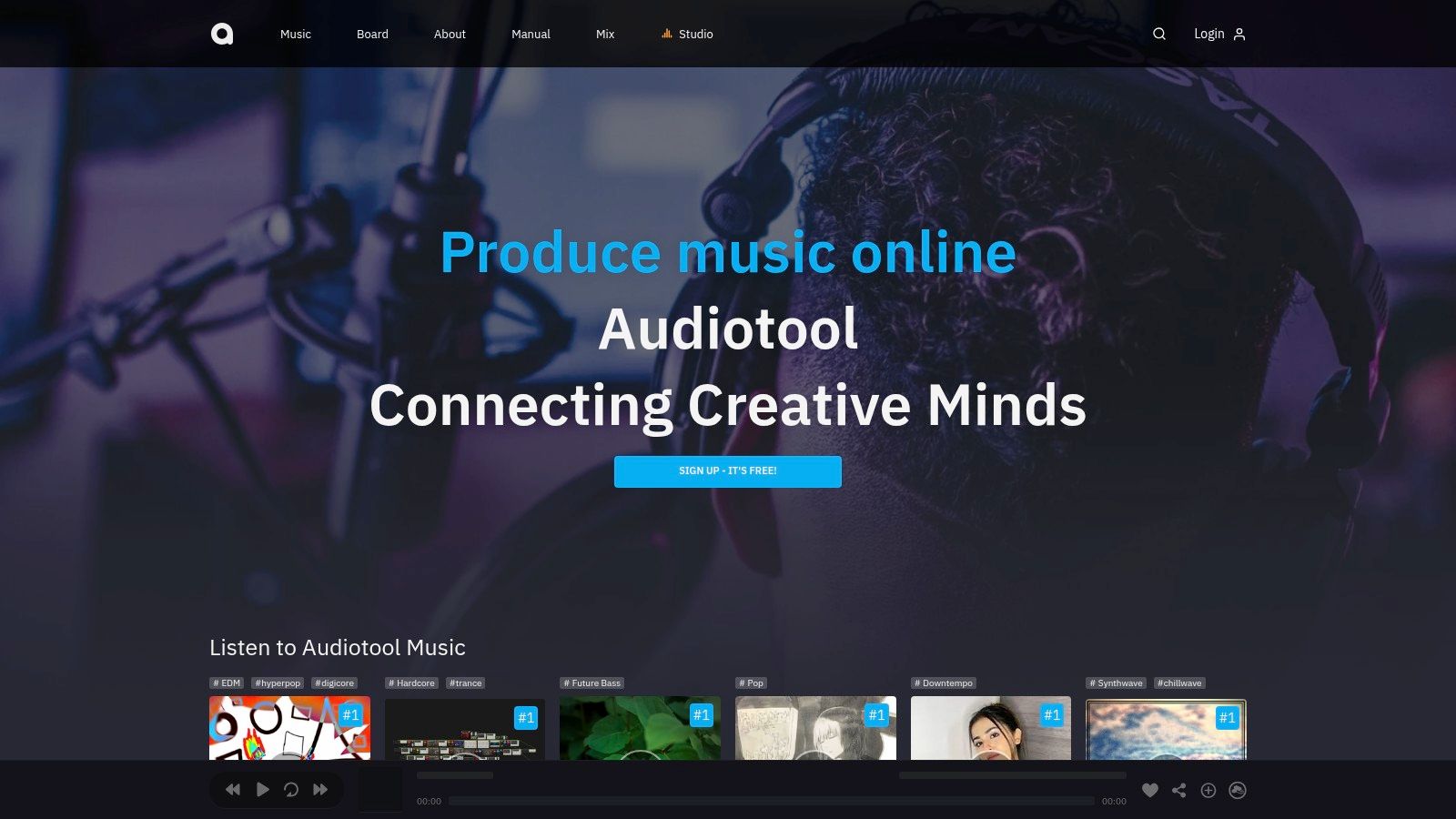
What truly sets Audiotool apart is its deeply integrated community and real-time collaboration features. You can invite other users into your project session to work together simultaneously, a powerful tool for learning and creating with others. The platform also boasts an extensive, user-driven sample library and a space to publish your finished tracks directly to the Audiotool community for feedback.
Key Features and User Experience
The modular workflow encourages experimentation by letting you virtually "patch" cables between different devices, much like a real-world modular synth setup. This hands-on approach can be incredibly inspiring, though it may present a slight learning curve for absolute beginners accustomed to more traditional DAW layouts.
- Cloud-Based & Collaborative: Work from anywhere and collaborate with other producers in real-time. All project data is stored securely in the cloud.
- Extensive Device Library: Comes packed with powerful virtual synthesizers like the Heisenberg, Pulverisateur, and Bassline, plus a massive array of effects and utility tools.
- No Installation Required: As a browser-based platform, it eliminates setup hassles and compatibility issues, making it instantly accessible.
Limitations and Practical Advice
The primary limitation of Audiotool is its reliance on a stable internet connection; you cannot work offline. Performance can also be dependent on your computer's processing power and the browser you use, with complex projects sometimes causing strain. Despite this, its collaborative nature and zero-cost barrier to entry make it an exceptional choice for electronic music producers who want to learn synthesis and connect with a creative community without any financial investment.
Website: https://www.audiotool.com/
Top 12 Free Music Production Software Comparison
| DAW / Platform | Core Features & Compatibility | User Experience ★★★★☆ | Value Proposition 💰 | Target Audience 👥 | Unique Selling Points ✨ | Price Point 💰 |
|---|---|---|---|---|---|---|
| Top 10 Best Free DAWs (2025) | Curated list of top free DAWs, versatile platforms | ★★★★☆ Expert-curated, up-to-date | 🏆 Best free options, wide skill range | Beginners to pros | Comprehensive, updated yearly | Free |
| LMMS | Cross-platform, VST/LADSPA support, piano roll | ★★★☆☆ Functional but UI dated | 💰 Completely free, no restrictions | Intermediate users, open-source fans | Open-source, plugin support | Free |
| GarageBand by Apple | Intuitive, loops/instruments, Apple ecosystem | ★★★★☆ Beginner-friendly | 💰 Free on Apple devices | Beginners on macOS/iOS | Seamless Apple integration | Free (Apple devices only) |
| BandLab | Cloud-based, real-time collaboration, multi-platform | ★★★★☆ Social, collaborative | 🏆 Free with strong community | All levels, remote collaborators | Online DAW, cross-device collaboration | Free |
| Cakewalk by BandLab | Pro features, unlimited tracks, Windows only | ★★★★☆ Professional-grade | 🏆 Advanced tools free for Windows | Beginners to advanced Windows users | ProChannel console, VST3/ARA support | Free |
| Audacity | Multi-track editor, effects, cross-platform | ★★★☆☆ Lightweight, UI dated | 💰 Free and open-source | Podcasting, basic editing | Simple audio editor, noise reduction | Free |
| Tracktion T7 | Unlimited tracks, automation, cross-platform | ★★★★☆ User-friendly, beginner suited | 💰 Fully featured free DAW | Beginners and experienced | Unlimited MIDI/audio, cross-platform | Free |
| Waveform Free by Tracktion | Unlimited tracks, VST support, automation | ★★★★☆ User-friendly | 💰 No track limits, frequent updates | Users wanting free pro features | Free with pro-grade features | Free |
| SoundBridge | Built-in drum machine, touchscreen support, VST | ★★★★☆ Easy for beginners | 💰 Free with sample library | Beginners needing simple DAW | Touchscreen compatibility, drum machine | Free |
| Ardour | Highly customizable, advanced routing, plugin support | ★★★☆☆ Professional but complex | 💰 Open-source pro DAW | Experienced, tech-savvy | Full pro DAW customization | Free/Open-source |
| Qtractor | Linux-only, multi-track, plugin support | ★★★☆☆ Lightweight, efficient | 💰 Free for Linux users | Linux users, intermediate | Linux-native, efficient workflow | Free |
| Audiotool | Browser-based, real-time collab, modular interface | ★★★★☆ Collaborative, accessible | 🏆 No install, anytime access | All levels, remote collaboration | Fully cloud-based, drag & drop modular setup | Free |
Final Thoughts
The journey into music production can feel like stepping into a vast, complex world filled with technical jargon and expensive gear. However, as we've explored, the barrier to entry has never been lower. The wealth of high-quality, free music production software for beginners available today is nothing short of revolutionary. You no longer need a lavish studio budget to start creating the sounds you hear in your head. The tools are here, they are powerful, and they are waiting for you.
We've delved into a diverse lineup, from the comprehensive, traditional DAW experience of Cakewalk by BandLab and Waveform Free to the uniquely collaborative, cloud-based environment of BandLab. We've seen how tools like GarageBand offer an incredibly intuitive and seamless entry point for Apple users, while open-source champions like LMMS and Ardour provide deep customization for those willing to learn. Each piece of software has its own philosophy, workflow, and ideal user.
Recapping the Core Takeaways
Your primary goal now is to move from analysis to action. Don't fall into the trap of "analysis paralysis," where you spend more time researching tools than using them. The best free music production software is ultimately the one that you open and create with.
To distill our findings, remember these key points:
- No "One-Size-Fits-All" Solution: The perfect DAW for a beatmaker focused on hip-hop (like LMMS) will be different from what a singer-songwriter needs to record acoustic guitar and vocals (where Cakewalk or Audacity might excel).
- Limitations are Learning Opportunities: Free software will have limitations. Instead of viewing this as a roadblock, see it as a creative constraint. Learning to work around a missing feature or a limited track count forces you to become a more resourceful and skilled producer.
- Workflow is King: A flashy feature set is useless if the software's workflow feels clunky or counterintuitive to you. Prioritize a tool that feels natural and keeps you in a creative flow. This is why trying two or three options is so critical.
Your Actionable Next Steps: Choosing Your Creative Hub
So, where do you go from here? The path forward is clear: pick a tool and make a track. It doesn’t have to be a masterpiece. The goal is completion, not perfection.
Follow this simple framework to make your choice:
- Define Your Primary Goal: Are you mainly recording live instruments, making electronic beats, composing orchestral scores, or collaborating online? Your answer will immediately narrow the field. For instance, a collaborator should look at BandLab first, while an electronic artist might gravitate towards Waveform Free.
- Assess Your Technical Comfort: If you are completely new to music software, start with the most beginner-friendly options like GarageBand or BandLab. If you have some technical aptitude and enjoy customization, consider a more robust platform like Cakewalk or Ardour.
- Commit to a "Trial Week": Choose one or two DAWs that seem like the best fit. Spend one full week with each. Don't just explore the menus; follow a tutorial and create a short, simple song from start to finish. This hands-on experience is the only true way to know if a DAW clicks with your creative process.
By embracing the free music production software for beginners we've outlined, you are equipping yourself with everything you need to translate your musical ideas into reality. The most important step is the one you take right now. Download a program, plug in your headphones, and start creating. The world is ready to hear what you have to say.
As you begin composing, you'll discover that a compelling chord progression is the foundation of any great song. To accelerate your songwriting and music theory skills, check out ChordX. Our tool is designed to help you discover, experiment with, and understand the chords that bring your music to life, integrating perfectly with the free music production software you're learning. Explore ChordX to build stronger harmonic foundations for your tracks today.

